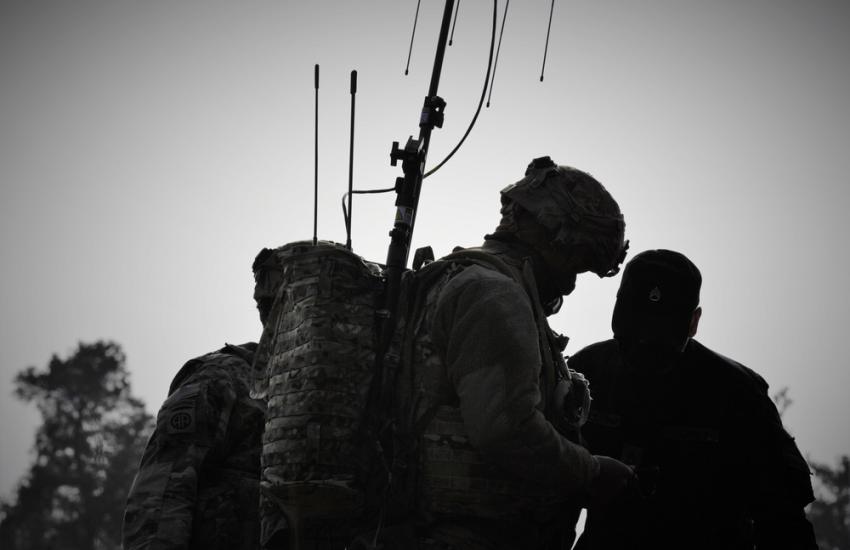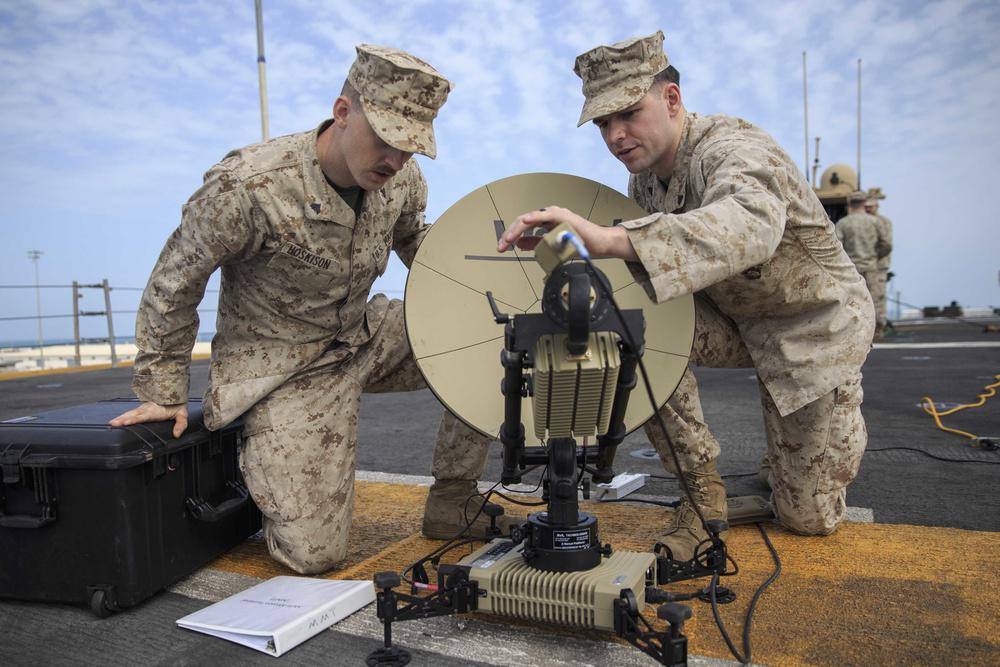The Next Revolution in Military Affairs
As nations have experienced throughout history, periods of violent change compel military institutions to adapt to regain a state of normalcy. Technological change alone is insufficient to generate a revolution in military affairs. Rather than simply employ new technologies, militaries must adapt their organizations and develop innovative operational concepts to fundamentally alter the character of combat.
The Department of Defense (DoD) is undertaking numerous efforts to evolve for future warfare, yet the U.S. military remains ill-prepared for competition and conflict in the Information Age. To best adapt to the anticipated character of future conflict, the DoD should develop a joint force more educated in operations in the information environment (OIE) and electromagnetic spectrum operations (EMSO), plus develop more realistic joint training for contested and degraded environments.
First, the DoD should develop a joint force more educated in OIE—specifically, influence operations—and EMSO. The global war on terror created generations of military professionals ill-versed in the importance of information and conditioned to highly permissive environments. With a myopic focus on fires to achieve military objectives, DoD generated tactical victories but was unable to prevent strategic failure in Iraq or Afghanistan in 2014 and 2021, respectively. Influencing an adversary requires much more than adroit maneuver and physical destruction: OIE are required to impact an enemy’s will to fight. The goal of influence operations is to shape decisions or to change or preserve behaviors of adversaries and select target audiences, compelling those actors to behave in ways advantageous to the commander. To truly influence an adversary’s will, all joint warfighters must view information as a form of fires, protection and maneuver—simultaneously. Information is not a panacea, however. The DoD will not be able to bend an adversary’s will with information alone.
Information is the substance of intelligence, decision-making and command and control; an instrument of power; and a warfighting function. To help the joint force understand the changing character of warfare, the Joint Staff promoted information to a new joint warfighting function in 2017. Each service is attempting to adapt for information warfare, but the joint force writ large requires a holistic effort to ensure the DoD develops a common lexicon and effective strategy. Yet there remains no single entity responsible for information warfare across the DoD. The United States must establish a functional combatant command for information warfare, akin to the role once performed by the now-defunct U.S. Information Agency.
The DoD has only begun to realize that vis-à-vis Russia and China in the information domain, the United States is already at war. Russia’s “information confrontation” is focused on the strategic level, weaving a meta-narrative to protect the regime and buffer zones along its former imperial borders. Russia is particularly adept at wielding disinformation, false information deliberately created or disseminated with the purpose of causing harm, which differs from misinformation, information that is false but not intended to cause harm. Disinformation was a critical component in the lead-up to Russia’s latest infiltration of Ukraine with claims that the West was pushing Ukraine toward a conflict while Russia itself was merely repositioning troops on its own territory and not deploying combat forces along shared borders. China turns to other information warfare capabilities to meet its ends, using diplomatic appeals to shared values with other authoritarian systems and covert influence—including illicit funding, bribery and influencing elections—to shift policy, strategy and public opinion toward China’s favor. The Chinese Communist Party uses One Belt One Road to make developing countries—primarily in Southeast Asia, Africa and Latin America—more economically reliant upon China, enticing target nations into massive infrastructure projects that leave them saddled with debt and vulnerable to coercion.
The joint force must be trained to recognize and better understand these threats to safeguard DoD’s interests in the information environment. Russian disinformation must be discredited. The rapid sharing of intelligence to expose Russia’s disinformation prior to the 2022 invasion of Ukraine provides a valuable case study to use in training future military leaders on the importance of information in contemporary warfare. Following international pushback due to its debt-trap diplomacy and economic-imperialist projects, China rebranded the One Belt One Road as Belt and Road Initiative to convey a softer message and imply more inclusion in its future development. Military professionals must expose China’s thinly veiled expansionism masquerading as benevolent outreach, in part by using the original term of One Belt One Road in communications with China’s neighbors in the Indo-Pacific region. Military professionals may also educate their families and fellow citizens to identify when and how America’s adversaries are employing influence operations. Countering Russian and Chinese information warfare requires not just whole-of-government actions but a whole-of-society effort.
While DoD’s slowly developing recognition of information’s importance is a long-overdue advancement into the Information Age, the department has yet to properly elevate the importance of the electromagnetic spectrum (EMS), the entire range of light upon which the modern world relies. The EMS includes radio waves, microwaves, infrared, visible light, ultraviolet radiation, X-rays and gamma rays. From radio and television to fiber optics, satellite communications and 5G cellular networks, the EMS has enabled society’s transition from the Industrial Age to the Information Age.
Modern militaries use electromagnetic waves for command and control, communication, intelligence, radar, jamming and myriad other processes. The EMS is important not only for conveying information. In a contested battlespace against highly capable adversaries, EMS superiority is critical to survival.
While the DoD provides “formal training and education” for EMS professionals in crucial billets, EMS training and education must be expanded to include more of the department. EMS protection, for example, is currently limited primarily to individuals assigned as frequency managers or other spectrum management specialists. To ensure survival, modern military professionals must holistically employ an electronic warfare system-of-systems to dominate in the EMS, incorporating deception into nearly all facets of operations. Achieving EMS superiority will require many adept operators fluent in the technology, tactics, techniques and procedures of EMSO.
Second, the DoD must develop more realistic joint training for contested and degraded environments. The joint force must significantly grow its pool of OIE- and EMSO-capable operators to achieve the visions outlined in the Joint Warfighting Concept and the Joint All-Domain Command and Control modernization concept. DoD training does not include a sufficient focus on communicating and surviving within a contested environment. Over 20 years of global-war-on-terror operations against nonpeer enemies such as al-Qaeda, Islamic State and the Taliban conditioned military professionals to operations in highly permissive environments.
The next conflict with a peer adversary will afford no such freedom of movement across all domains, particularly within the EMS. China and Russia are fielding increasingly advanced passive sensors and jammers to exploit the dependence of expeditionary U.S. forces on active radars for air defense and long-range radio frequency communications for command and control. Chinese doctrine advises imposing cross-domain effects on U.S. weapons systems that rely upon unimpeded access to the spectrum. Russia is using the real-world experience of its forces in Ukraine to develop new approaches to electronic and cyber warfare in “deep battle” and “information confrontation.” Central to both adversaries’ planning is countering the United States through information warfare and exploiting U.S. reliance on the spectrum for communication and sensing capabilities.

The truly valuable component of remote-sensing data is the information derived from analysis that enables decision-making. Cyberspace provides an avenue to inflict severe damage on the U.S. military by manipulating networks, the machines connected to networks and the ideas transmitted over them. The DoD must consider the actions of third-party actors such as Anonymous and other “hacktivists” that can contribute to the contested character of the Information Age battlespace. Contested environment training must also consider the private sector’s roles and how Google, Apple, Microsoft, Starlink, Twitter, Meta (Facebook), etc., will either help or hinder Information Age warfare. U.S. military training events and exercises must seek to operate in a contested EMS environment by simulating the capabilities of peer adversaries and third-party actors.
Training in a degraded (and congested) EMS environment is also critical to ensuring joint force success and survival. Constraints on military EMS access will only grow with the allocation of spectrum to 5G mobile communications, expanded Wi-Fi coverage and the proliferation of ubiquitous sensing and communications capabilities on vehicles and consumer products. Given the growing variety of adversary countermeasures and diverse demands for commercial spectrum, attempting to modify or replace DoD EMS systems wholesale to avoid specific threats and civilian encroachment is likely to be unaffordable and late-to-need.
Through more realistic training events, military professionals must learn how to navigate and operate within a degraded EMS environment with their current tools to be prepared to fight tonight. Training will require new infrastructure, leveraging both simulators and actual EMS ranges that enable the joint force to fully stretch its capabilities and drive further development. OIE training writ large will require effective exercise control mechanisms to manage execution and evaluation.
The DoD must become more risk-tolerant, willing to integrate disruptive and unproven technologies to allow the joint force to innovate on its own and take advantage of the latest breakthroughs in artificial intelligence, machine learning and quantum computing. The “electronization” of warfare is proceeding apace. By testing small and failing forward in the relative safety of a degraded training environment, the joint force may begin to make up lost ground vis-à-vis China’s military in particular.
Only through more realistic training will military professionals learn how to navigate and operate within a degraded EMS environment. Though the transition will be painful, the DoD must invert the training paradigm and require exercise participants to operate in a degraded environment for the preponderance of exercise windows, gaining valuable knowledge and experience to ensure joint force survivability and effectiveness against highly capable adversaries in conflict.
With a joint force more educated in OIE and EMSO and better trained for contested and degraded environments, the DoD can best its adversaries in redefining the character of modern warfare. The DoD must develop “headroom,” the space and time required to allow systemic development of a leadership culture and affect change. The DoD can use information and the spectrum to become the pacing threat for its adversaries again, but it must throw off the yoke of its Industrial Age training model, safeguarding America’s global leadership role in guiding civilization through the Information Age and beyond.
Maj. Michael P. Kersten, USAFR, currently serves as chief, Joint Targeting and Fires Integration, Intelligence Directorate, Special Operations Command Central, MacDill Air Force Base, Florida, leading the planning and execution of joint target intelligence and joint fires across current and future operations in support of theater Special Operations Forces.






Comments